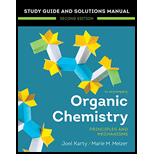
Concept explainers
(a)
Interpretation:
The IUPAC name for the given compound is to be determined.
Concept introduction:
In case of molecules containing a
If the root is a chain, numbering begins from that end of the chain which encounters the
The carbon atoms having a double or triple bond between them are always assigned C1 and C2, if the root is a ring. This must be done such that the locator numbers for the substituents are minimized. The lower of the two locator numbers for the
Answer to Problem B.27P
The IUPAC name for the given compound is
Explanation of Solution
The given molecule is:
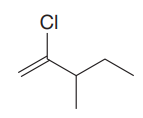
In this molecule, the longest carbon chain containing the double bond has five carbon atoms. Hence, the root is pentene. The root is numbered such that the double bonded carbon atoms get the lowest numbers. Thus, the chain should be numbered from the left-terminal carbon atom. The carbon carbon double bond is present between C1 and C2 carbon atoms, and thus, the lower locator number - 1 is added immediately before the suffix, ene. Thus, the complete root name for the molecule is:
The numbering system is shown below:
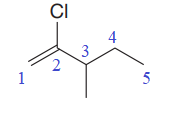
One chlorine atom and one methyl group is attached at C2 and C3 carbon atoms of the root. Out of chloro and methyl, chloro comes first alphabetically, hence it is written before the methyl.
Thus, the IUPAC name of the compound is:
The IUPAC name of the compound is written according to the rules for nomenclature.
(b)
Interpretation:
The IUPAC name for the given compound is to be determined.
Concept introduction:
In case of molecules containing a
If the root is a chain, numbering begins from that end of the chain which encounters the
The carbon atoms having a double or triple bond between them are always assigned C1 and C2, if the root is a ring. This must be done such that the locator numbers for the substituents are minimized. The lower of the two locator numbers for the
Answer to Problem B.27P
The IUPAC name for the given compound is:
Explanation of Solution
The given compound is:

In this molecule, the longest carbon chain containing the double bond has six carbon atoms. Hence, the root is hexene. The root is numbered such that the double bonded carbon atoms get the lowest numbers. Thus, the chain should be numbered from the left-terminal carbon atom. The carbon-carbon double bond is present between C1 and C2 carbon atoms, and thus, the lower locator number -1 is added immediately before the suffix, ene. Thus, the complete root name for the molecule is:
The numbering system is shown below:

One methyl group is attached at the C5 carbon atom to the root.
Thus, the IUPAC name of the compound is:
The IUPAC name of the compound is written according to the rules for nomenclature.
(c)
Interpretation:
The IUPAC name for the given compound is to be determined.
Concept introduction:
In case of molecules containing a
If the root is a chain, numbering begins from that end of the chain which encounters the
The carbon atoms having a double or triple bond between them are always assigned C1 and C2, if the root is a ring. This must be done such that the locator numbers for the substituents are minimized. The lower of the two locator numbers for the
Answer to Problem B.27P
The IUPAC name for the given compound is
Explanation of Solution
The given molecule is:

In this molecule, the largest carbon ring containing the double bond has five carbon atoms. Hence, the root is cyclopentene. For a ring, the carbon atoms of the double bond are always assigned as C1 and C2. The ring is then numbered clockwise so as to give the remaining substituents the next lowest possible locator numbers. The numbering system is shown below:
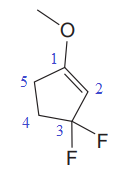
At C1, C3 and C3 carbon atoms of the ring, one methoxy group and two fluorine atoms are attached. The substituents will be named according to the alphabetical order.
Thus, the IUPAC name of the compound is:
The IUPAC name of the compound is written according to the rules for nomenclature.
(d)
Interpretation:
The IUPAC name for the given compound is to be determined.
Concept introduction:
In case of molecules containing a
If the root is a chain, numbering begins from that end of the chain which encounters the
The carbon atoms having a double or triple bond between them are always assigned C1 and C2, if the root is a ring. This must be done such that the locator numbers for the substituents are minimized. The lower of the two locator numbers for the
Answer to Problem B.27P
The IUPAC name for the given compound is
Explanation of Solution
The given compound is:
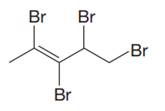
In this molecule, the longest carbon chain containing the double bond has five carbon atoms. Hence, the root is pentene. The root is numbered such that the double bonded carbon atoms get the lowest numbers. Thus, the chain should be numbered from the left-terminal carbon atom. The carbon-carbon double bond is present between C2 and C3 carbon atoms, and thus, the lower locator number - 2 is added immediately before the suffix, ene. Thus, the complete root name for the molecule is:
The numbering system is shown below:
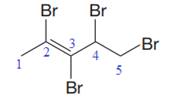
Four bromine atoms are attached at C2, C3, C4, and C5 carbon atoms to the root. Thus, prefix ‘tetra’ is used immediately before the name of the substituent.
Thus, the IUPAC name of the compound is:
The IUPAC name of the compound is written according to the rules for nomenclature.
(e)
Interpretation:
The IUPAC name for the given compound is to be determined.
Concept introduction:
In case of molecules containing a
If the root is a chain, numbering begins from that end of the chain which encounters the
The carbon atoms having a double or triple bond between them are always assigned C1 and C2, if the root is a ring. This must be done such that the locator numbers for the substituents are minimized. The lower of the two locator numbers for the
Answer to Problem B.27P
The IUPAC name for the given compound is
Explanation of Solution
The given compound is:

In this molecule, the longest carbon chain containing the double bond has six carbon atoms. Hence, the root is hexene. The root is numbered such that the double bonded carbon atoms get the lowest numbers. If there is a tie, the chain is numbered such that the substituents get the lowest locator numbers. Thus, the chain should be numbered from the left-terminal carbon atom. The carbon-carbon double bond is present between C3 and C4 carbon atoms, and thus, the lower locator number - 3 is added immediately before the suffix, ene. Thus, the complete root name for the molecule is:
The numbering system is shown below:
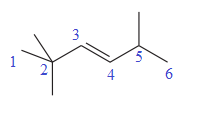
Three methyl groups are attached at C2, C2, and C5 carbon atoms to the root. Thus, prefix ‘tri’ is used immediately before the name of the substituent.
Thus, the IUPAC name of the compound is
The IUPAC name of the compound is written according to the rules for nomenclature.
(f)
Interpretation:
The IUPAC name for the given compound is to be determined.
Concept introduction:
In case of molecules containing a
If the root is a chain, numbering begins from that end of the chain which encounters the
The carbon atoms having a double or triple bond between them are always assigned C1 and C2, if the root is a ring. This must be done such that the locator numbers for the substituents are minimized. The lower of the two locator numbers for the
Answer to Problem B.27P
The IUPAC name for the given compound is:
Explanation of Solution
The given molecule is:

In this molecule, the largest carbon ring containing the double bond has four carbon atoms. Hence, the root is cyclobutene. For a ring, the carbon atoms of the double bond are always assigned as C1 and C2. The ring is then numbered clockwise so as to give the remaining substituents the next lowest possible locator numbers. The numbering system is shown below:
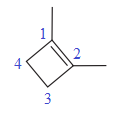
At C1 and C2 carbon atoms of the ring, two methyl groups are attached respectively. Thus, prefix ‘di’ should be added immediately before the name of the substituent.
Thus, the IUPAC name of the compound is:
The IUPAC name of the compound is written according to the rules for nomenclature.
(g)
Interpretation:
The IUPAC name for the given compound is to be determined.
Concept introduction:
In case of molecules containing a
If the root is a chain, numbering begins from that end of the chain which encounters the
The carbon atoms having a double or triple bond between them are always assigned C1 and C2, if the root is a ring. This must be done such that the locator numbers for the substituents are minimized. The lower of the two locator numbers for the
Answer to Problem B.27P
The IUPAC name for the given compound is:
Explanation of Solution
The given molecule is:

In this molecule, the double bond cannot be a part of the longest carbon chain or the largest carbon ring. Thus, in this case, the double bond will be a substituent to the parent ring, cyclopentane. The numbering system is shown below:
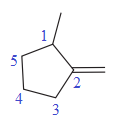
At C1 carbon atom, there is one methyl group attached to the root. At C2 carbon atom, the double bond is attached which is named as methylene.
Thus, the IUPAC name of the compound is:
The IUPAC name of the compound is written according to the rules for nomenclature.
(h)
Interpretation:
The IUPAC name for the given compound is to be determined.
Concept introduction:
In case of molecules containing a
If the root is a chain, numbering begins from that end of the chain which encounters the
The carbon atoms having a double or triple bond between them are always assigned C1 and C2, if the root is a ring. This must be done such that the locator numbers for the substituents are minimized. The lower of the two locator numbers for the
Answer to Problem B.27P
The IUPAC name for the given compound is:
Explanation of Solution
The given compound is:
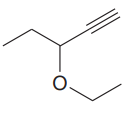
In this molecule, the longest carbon chain containing the triple bond has five carbon atoms. Hence, the root is pentyne. The root is numbered such that the triple-bonded carbon atoms get the lowest numbers. Thus, the chain should be numbered from the top right carbon atom. The carbon-carbon triple bond is present between C1 and C2 carbon atoms, and thus, the lower locator number - 1 is added immediately before the suffix, yne. Thus, the complete root name for the molecule is
The numbering system is shown below:

One methoxy group is attached at the C3 carbon atom to the root.
Thus, the IUPAC name of the compound is:
The IUPAC name of the compound is written according to the rules for nomenclature.
Want to see more full solutions like this?
Chapter B Solutions
Organic Chemistry: Principles And Mechanisms: Study Guide/solutions Manual (second)
- For Raman spectroscopy/imaging, which statement is not true regarding its disadvantages? a) Limited spatial resolution. b) Short integration time. c) A one-dimensional technique. d) Weak signal, only 1 in 108 incident photons is Raman scattered. e) Fluorescence interference.arrow_forwardUsing a cell of known pathlength b = 1.25115 x 10-3 cm, a water absorption spectrum was measured. The band at 1645 cm-1, assigned to the O-H bending, showed an absorbance, A, of 1.40. a) Assuming that water density is 1.00 g/mL, calculate the water molar concentration c (hint: M= mole/L) b) Calculate the molar absorptivity, a, of the 1645 cm-1 band c) The transmitted light, I, can be written as I= Ioexp(-xb), where x is the absorption coefficient (sometimes designated as alpha), Io is the input light, and b is the cell pathlength. Prove that x= (ln10)*x*c. (Please provide a full derivation of the equation for x from the equation for I). d) Calculate x for the 1645 cm-1 bandarrow_forwardI need help with the follloaingarrow_forward
- For a CARS experiment on a Raman band 918 cm-1, if omega1= 1280 nm, calculate the omega2 in wavelength (nm) and the CARS output in wavelength (nm).arrow_forwardI need help with the following questionarrow_forwardFor CARS, which statement is not true regarding its advantages? a) Contrast signal based on vibrational characteristics, no need for fluorescent tagging. b) Stronger signals than spontaneous Raman. c) Suffers from fluorescence interference, because CARS signal is at high frequency. d) Faster, more efficient imaging for real-time analysis. e) Higher resolution than spontaneous Raman microscopy.arrow_forward
- Draw the major product of the Claisen condensation reaction between two molecules of this ester. Ignore inorganic byproducts. Incorrect, 5 attempts remaining 1. NaOCH3/CH3OH 2. Acidic workup Select to Draw O Incorrect, 5 attempts remaining The total number of carbons in the parent chain is incorrect. Review the reaction conditions including starting materials and/or intermediate structures and recount the number of carbon atoms in the parent chain of your structure. OKarrow_forwardUsing a cell of known pathlength b = 1.25115 x 10-3 cm, a water absorption spectrum was measured. The band at 1645 cm-1, assigned to the O-H bending, showed an absorbance, A, of 1.40. a) Assuming that water density is 1.00 g/mL, calculate the water molar concentration c (hint: M= mole/L) b) Calculate the molar absorptivity, a, of the 1645 cm-1 band c) The transmitted light, I, can be written as I= Ioexp(-xb), where x is the absorption coefficient (sometimes designated as alpha), Io is the input light, and b is the cell pathlength. Prove that x= (ln10)*x*c d) Calculate x for the 1645 cm-1 bandarrow_forwardConvert 1.38 eV into wavelength (nm) and wavenumber (cm-1) (c = 2.998 x 108 m/s; h = 6.626 x 10-34 J*s).arrow_forward
 ChemistryChemistryISBN:9781305957404Author:Steven S. Zumdahl, Susan A. Zumdahl, Donald J. DeCostePublisher:Cengage Learning
ChemistryChemistryISBN:9781305957404Author:Steven S. Zumdahl, Susan A. Zumdahl, Donald J. DeCostePublisher:Cengage Learning ChemistryChemistryISBN:9781259911156Author:Raymond Chang Dr., Jason Overby ProfessorPublisher:McGraw-Hill Education
ChemistryChemistryISBN:9781259911156Author:Raymond Chang Dr., Jason Overby ProfessorPublisher:McGraw-Hill Education Principles of Instrumental AnalysisChemistryISBN:9781305577213Author:Douglas A. Skoog, F. James Holler, Stanley R. CrouchPublisher:Cengage Learning
Principles of Instrumental AnalysisChemistryISBN:9781305577213Author:Douglas A. Skoog, F. James Holler, Stanley R. CrouchPublisher:Cengage Learning Organic ChemistryChemistryISBN:9780078021558Author:Janice Gorzynski Smith Dr.Publisher:McGraw-Hill Education
Organic ChemistryChemistryISBN:9780078021558Author:Janice Gorzynski Smith Dr.Publisher:McGraw-Hill Education Chemistry: Principles and ReactionsChemistryISBN:9781305079373Author:William L. Masterton, Cecile N. HurleyPublisher:Cengage Learning
Chemistry: Principles and ReactionsChemistryISBN:9781305079373Author:William L. Masterton, Cecile N. HurleyPublisher:Cengage Learning Elementary Principles of Chemical Processes, Bind...ChemistryISBN:9781118431221Author:Richard M. Felder, Ronald W. Rousseau, Lisa G. BullardPublisher:WILEY
Elementary Principles of Chemical Processes, Bind...ChemistryISBN:9781118431221Author:Richard M. Felder, Ronald W. Rousseau, Lisa G. BullardPublisher:WILEY





